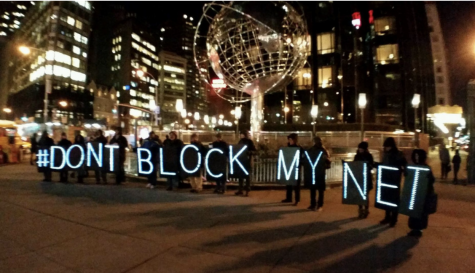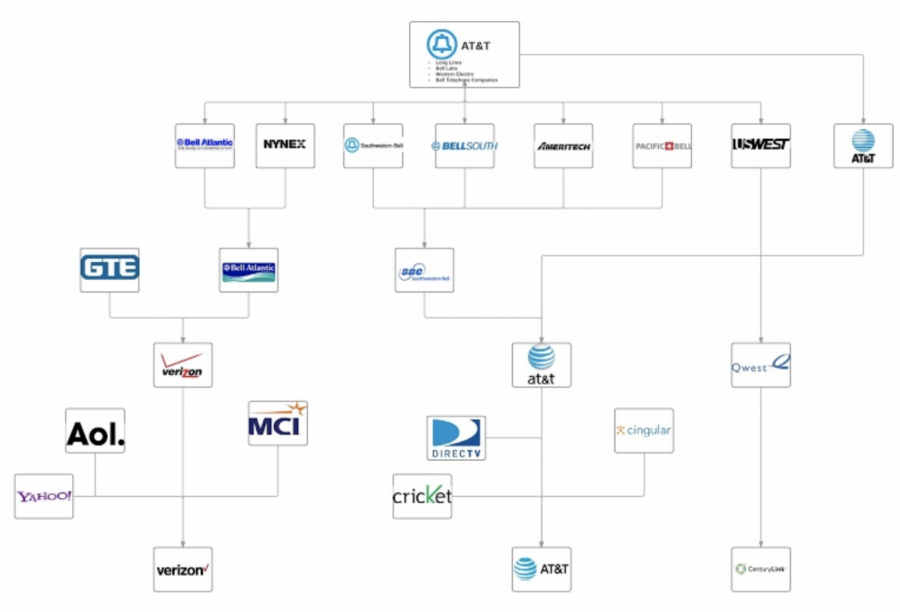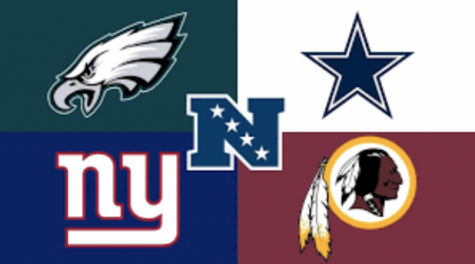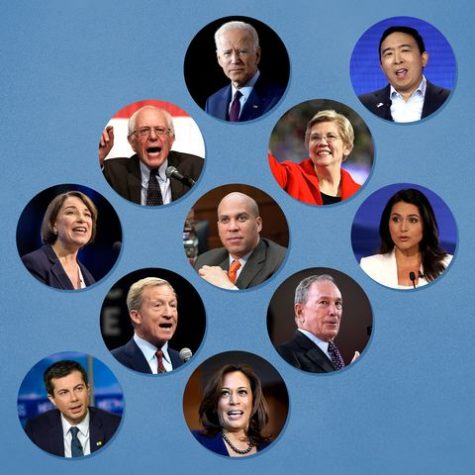The End of Net Neutrality: Using the Telecom Industry’s Past to Make Sense of What Is Going On Now
Flow chart illustrating the mergers and buyouts of the different telecom companies that descended from the Bell System from the years 1983 to 2016. Each logo is used as a representation of their respective organizations and are secured by their own copyright.

The possibility of the end of net neutrality sparks protest.
Last month, Chairman Ajit Pai announced that the FCC would start to roll back the Obama-era net neutrality rules. The basic concept of net neutrality is that the government would regulate ISPs (Internet Service Providers) to prevent them from slowing down or blocking certain websites and from trying to offer better services at an extra fee. It pretty much just means that ISPs would be “neutral” in their delivery of the internet, regardless of participants, sophistication, or socio-economic status. The rationale behind the removal of net neutrality, is that this will spur greater competition within the telecom industry and give telecoms the option to change their business models and experiment (Washington Examiner).
We’ve heard this message before. There has been a trend since the late 70s to deregulate huge industries in the name of a “free market.” I do not believe at all that getting rid of these rules protecting the internet is going to give the consumer a better experience by letting Verizon try out new business models. We can not trust these companies to regulate themselves through the free market because it just simply hasn’t worked in the past.
Thirty-five years ago, a settlement had been reached between AT&T and the Justice Department over an antitrust suit filed in 1974. At that time, American Telephone & Telegraph Corporation was the largest company in American history, with over $150 billion in assets and 1 million plus employees. It represented 80% of the American telecom industry (Time, 1983), making it a monopoly. Along with this, AT&T was perfectly vertically integrated: they got new inventions from the R&D department of Bell Labs, equipment and telephones through their largest supplier Western Electric, had almost total control over long distance calls with AT&T Long Lines, and 22 local Bell Operating Companies dealing with the day-to-day installation and maintenance serving all the continental US. This collection of companies (dubbed the “Bell System” and affectionately called “Ma Bell”) gave Americans the greatest telephone service in the world.
However, the government decided to shake things up, and sought to introduce more competition into telecom industry by breaking up AT&T’s monopoly and removing the manufacturing department of Western Electric (Bell System Memorial). AT&T had always been heavily regulated by the government, and it agreed to be since the early 20th century. AT&T’s president from 1907 to 1919, Theodore Newton Vail, believed that the telephone should be available to all Americans, and the best way to go about doing this was to have an efficient monopoly covering all of the US. To combat the trust-busters of the time, Vail sought out government regulation, and a symbiotic relationship between private corporation, government, and the public had been struck. The reign of Ma Bell was a great and fruitful one, nearly 80 years of excellent service and low costs. But all that was to come to an end.
With the strike of midnight on January 1st, 1984, the Bell System as we came to know it, ceased to exist. The Modified Final Judgement entailed that AT&T divest itself from the 22 local phone companies, but could keep Bell Labs, Long Lines, and Western Electric and be allowed to enter new markets (like the computer industry) which is was barred from in a 1956 antitrust settlement. The 22 local phone companies would then be combined into seven Regional Bell Operating Companies, or RBOCs for short. These new “Baby Bells” would handle phone service over their own respective mini-monopoly areas, but could not enter some markets like manufacturing and long distance (Indiana University). This new set up would ensure that the telecom industry would function in a new market free from regulation and be fertile for competition.
It did not take long for things to start going wrong. In 1996, Congress passed the Telecommunications Act which allowed the RBOCs to enter the long distance market and merge with each other. This further deregulation was to also spur more competition and innovation and give all Americans lower costs and more access to the internet. Almost immediately, the RBOCs started to merge and buy out with each other along with entering different markets. The family reunion of the sister Baby Bells has been widespread: Bell Atlantic merged with NYNEX in 1997 and then with independent company (meaning never a part of the original Bell System) GTE in 2000 to form Verizon, and Southwestern Bell Corporation (SBC) bought out Ameritech, Pacific Telesis, BellSouth, and even its own former parent, AT&T. SBC then assumed the identity of its parent, to become the “new” at&t.
To add insult to injury, the telecom companies are vertically integrated again. Comcast (whose roots are in the cable television industry and not the phone industry) is a great example of this. It offers cable TV service, internet, and is a huge media company too, owning NBC along with many others. The RBOCs are starting to catch up at a rapid pace. Verizon offers TV through FiOS and bought out Yahoo and AOL recently. AT&T already owns multiple wireless companies, acquired DirectTV, and is trying to takeover Time Warner (Time Warner is different than Time Warner Cable. TWC is a cable TV company and Time Warner is a media company). These ISPs are slowly amassing their each respective empire, with arguably more power and influence than the Bell System ever had or even wanted to have.
So here we are back where we started. The telecom giants reign over an oligopoly that is fairly deregulated, instead of a monopoly that is heavily regulated. The Justice Department has even admitted that breaking up the Bell System and deregulating the industry was a bad idea, and should have gone after the FCC instead because it failed to do a good job of implementing proper regulation (Robert W. Crandall, US DoJ). If the FCC sides with the ISP’s, whose primary objective is money, then the public stands no chance of fighting this. Net neutrality is one of the last remaining regulations protecting the fundamental values of a free and democratic internet. Without it, there will be little in the way of the telecoms to stop them from taking advantage of the American public.











